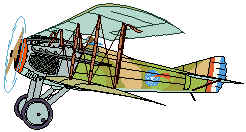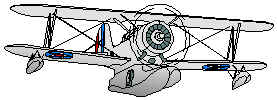|
Let's begin this second installment with a word ...
ALUMINUM DOPE
The Magic Finish
! |
It can be difficult to find color photos of aircraft made before World War II. That
often
makes it tough on scale modelers who want their renditions of planes from that era to be
correctly color - finished. Here's information that may help: 1911 - 1941 airplanes which
look light - colored in black-and-white photos were probably finished with
"aluminum dope".
There's an excellent reason for that. Unlike other paint pigments, which are finely-ground
powders, aluminum pigment
consists of tiny flat flakes. When the aluminum dope's thinner
evaporates, these miniature flakes slowly flatten out over their underlying surface and
overlap one another like the scales of a fish. That action is what makes aluminum
dope so valuable as an airplane finish.
The first aircraft to take advantage of aluminum dope's unique properties were Zeppelins.
The reason behind that was to reduce heat buildup from sunlight in the airships'
hydrogen gas cells. (In 1908 the Luftschiffe Zeppelin 4 [LZ4] had to be flown with
a nose-down attitude in the daytime because of excessive lift induced by the sun -
heated gas.) But Zeppelin engineers noticed that the aluminum
dope also made
the covering fabric less brittle and longer-lasting. The opaque, reflective
aluminum coating shielded the cloth from the detrimental
effects of U.V. (ultraviolet) light.
Early airplane experimenters -- largely individualists whose primary concern was
simply to get something with wings to carry them into the air (and safely back
down again!) -- used widely - varying covering and finishing materials. But by
1910 several airplane makers had found out about the virtues of aluminum
dope. In 1912 the British "Cellon" company
commenced the manufacturing
it. From then on it rapidly became a world-wide standard for aircraft finishes.
|

|
Because of its high "hiding power", aluminum dope has often been employed as an
undercoat or primer on airplanes (e.g. SPAD 13C-1's and DeH Mosquito bombers)
which carried a dark camouflaged final finish.
And
"between - the - wars" aircraft
with aluminum - doped surfaces proliferated.
After all, light weight has always been a vital criterion in aircraft of all kinds &
there is no lighter an opaque painted finish than aluminum
dope.
|

